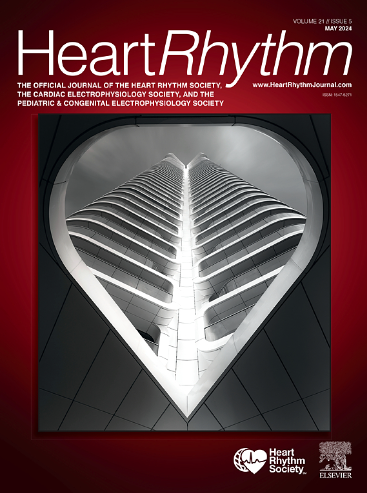阈值技术对大小和相位敏感重建图像的影响。
IF 5.7
2区 医学
Q1 CARDIAC & CARDIOVASCULAR SYSTEMS
引用次数: 0
摘要
背景:晚期钆增强(LGE)图像,使用幅度(MAG)或相敏反转恢复(PSIR)重建,由于它们对纵向磁化的处理,信号强度不同。这些差异影响LGE量化,在预测心脏事件时通常使用半最大全宽度(FWHM)或标准偏差(n-SD)阈值。目的:本研究评估FWHM和n-SD对MAG和psir衍生疤痕特征的影响。方法:对行LGE显像的缺血性心肌病(ICM)患者进行回顾性研究。评估了两种重建技术(MAG vs. PSIR)和两种阈值方法(FWHM vs. n-SD)。使用商用软件对LGE图像进行后处理,使用疤痕阈值为最大信号强度(FWHM)的40-60%和高于平均值(n-SD)的2-5个标准差。比较一级预防和二级预防植入式心律转复除颤器(ICD)患者的疤痕量化。结果:80例患者中,32例(40%)采用ICD进行一级预防。使用FWHM和n-SD阈值,PSIR成像显示的疤痕指标明显大于MAG,包括更大的边界区(BZ)(16.43±8.15g vs. 21.42±10.72g)。结论:本研究显示基于重建和阈值技术的心肌疤痕指标存在显著差异。PSIR在各种方法中始终提供可靠的疤痕表征,强调其标准化LGE-CMR工作流程和改善室性心律失常风险分层的临床潜力。本文章由计算机程序翻译,如有差异,请以英文原文为准。

Optimizing ventricular scar characterization in late-gadolinium enhancement cardiac MRI: Impact of thresholding techniques in magnitude and phase-sensitive reconstructed images
Background
Late gadolinium enhancement (LGE) images, reconstructed using magnitude (MAG) or phase-sensitive inversion recovery (PSIR) sequences, differ in signal intensities because of their handling of longitudinal magnetization. These differences influence LGE quantification, which typically uses full-width at half maximum (FWHM) or standard deviation (n-SD) thresholding when predicting cardiac events.
Objective
This study assessed the impact of FWHM and n-SD on MAG- and PSIR-derived scar characteristics.
Methods
Patients with ischemic cardiomyopathy undergoing LGE imaging were retrospectively studied. Two reconstruction techniques (MAG vs PSIR) and 2 thresholding methods (FWHM vs n-SD) were evaluated. LGE images were postprocessed with commercially available software, using scar thresholds of 40%–60% of the maximum signal intensity for FWHM and 2–5 SDs above the mean for n-SD. Scar quantification was compared between patients with primary and secondary prevention implantable cardioverter-defibrillator.
Results
Of the 80 patients, 32 (40%) had an implantable cardioverter-defibrillator for primary prevention. PSIR imaging showed significantly larger scar metrics than did MAG using FWHM and n-SD thresholding, including larger border zone (16.43 ± 8.15 g vs 21.42 ± 10.72 g; P<.001) and conduction corridor (CC) characteristics. MAG-based analysis revealed significant differences in scar and CC metrics. For PSIR, scar metrics were consistent across FWHM and n-SD. MAG-based analysis showed larger border zone and CC length in patients with primary prevention, with similar trends for PSIR.
Conclusion
This study demonstrates significant differences in myocardial scar metrics based on reconstruction and thresholding techniques. PSIR consistently provided robust scar characterization across methods, emphasizing its clinical potential to standardize LGE–cardiac magnetic resonance workflows and improve ventricular arrhythmia risk stratification.
求助全文
通过发布文献求助,成功后即可免费获取论文全文。
去求助
来源期刊

Heart rhythm
医学-心血管系统
CiteScore
10.50
自引率
5.50%
发文量
1465
审稿时长
24 days
期刊介绍:
HeartRhythm, the official Journal of the Heart Rhythm Society and the Cardiac Electrophysiology Society, is a unique journal for fundamental discovery and clinical applicability.
HeartRhythm integrates the entire cardiac electrophysiology (EP) community from basic and clinical academic researchers, private practitioners, engineers, allied professionals, industry, and trainees, all of whom are vital and interdependent members of our EP community.
The Heart Rhythm Society is the international leader in science, education, and advocacy for cardiac arrhythmia professionals and patients, and the primary information resource on heart rhythm disorders. Its mission is to improve the care of patients by promoting research, education, and optimal health care policies and standards.
 求助内容:
求助内容: 应助结果提醒方式:
应助结果提醒方式:


